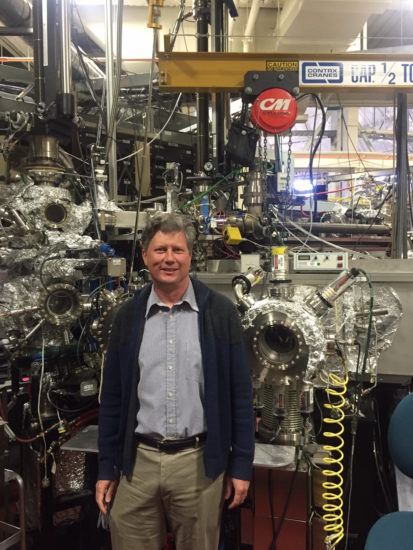 Andreas Scholl recently became a senior staff scientist, a job title that he sees not necessarily as indicative of a different job, but rather of the gradual change in his responsibilities over his 18 years at the ALS.
Andreas Scholl recently became a senior staff scientist, a job title that he sees not necessarily as indicative of a different job, but rather of the gradual change in his responsibilities over his 18 years at the ALS.
Describe your role at the ALS and its evolution over the years.
I started at the ALS as a postdoc, focusing on x-ray microscopy, in 1998 after completing my PhD in Germany. I went on to become a beamline scientist at Beamline 7.3.1 and I’m now a beamline scientist at Beamline 11.0.1, where we also have the PEEM-3 microscope. I mostly collaborate with users doing science in the area of magnetism, but there’s really a wide range of scientific interests at my beamline. I would say 30 to 40 percent of my users are coming from widely different research areas, and it’s fascinating because I get to help them in subjects that I don’t specialize in myself.
One of my roles with ESG is doing everything I can to help Howard Padmore find time to focus on his other responsibilities. We look at where the ALS needs to become a better facility; where we’re lacking, not just for users but also for our staff.
What do you enjoy most about working at the ALS?
I like the science environment and I like working on big problems. I like that in general we still have the resources to do completely new types of experiments, not just focusing on one set of systems but finding tools that are widely applicable to a range of scientific questions. Also to really work on the big problems like energy and computing. I also really like the practical aspect of my work; I’m an experimenter at heart. I guess I’m as much interested in the execution of science as in the dissemination of science, so I’m glad I’m actually involved in the hands-on science itself. My job in some ways requires me to be a specialist, but in other ways I need to be a jack-of-all-trades, working with instrumentation and engineering aspects of interdisciplinary experiments, and I really enjoy that.
What are some of the biggest challenges of working at the ALS?
One big challenge of course is workload; you have to stay one step ahead and anticipate when there’s going to be a high group workload and prepare for that. The only way to be a beamline scientist and not be under stress at all times is to run your beamline as efficiently as possible. When I first started at the ALS, everything at my beamline was manual, which meant that I basically had to be at the beamline all the time because users couldn’t do anything. Thankfully, now my current endstation is pretty much fully automated. If a user has a problem I can just log in from wherever I am and remotely fix things.
Did you always want to work at a synchrotron?
I always knew that I wanted to become a scientist. Physical science interested me the most because I wanted to understand the basic laws of nature. I think I ended up working in synchrotron science largely because of the influence of my PhD advisor,Wolfgang Eberhart, who is actually still a user at the ALS. Besides doing my lab research on ultrafast phenomena, I spent a lot of time in college at the synchrotron doing experiments and helping other graduate students doing their research.
What do you see as the future of the ALS?
I’ve always been interested in branching out into areas where x-rays haven’t been used before. Ultrafast experiments looking at time-dependent phenomena was one of these areas, and that led to the case for NGLS and the LCLS. Now with ALS-U as a possibility, there’s a huge opportunity to use its laser-like beam. I’m very interested in finding new ways to do experiments using coherence. I’m also really interested in where x-ray science will be in 10 to 20 years, thinking about what we’ll need for experiments of the future.
These big facilities like the ALS start up, and then they have a really productive period, and then there comes a point when they have to start thinking about the next steps. When I started here it was just after the Birgeneau report, and the ALS was being challenged to become a world-leading user facility. I was here during that time when we grew into a world-class soft x-ray facility. Now, after more than 20 years its clear that we need to take the next step. It’s awesome that our accelerator scientists know what that next step is, and that is a diffraction-limited storage ring that produces x-rays that are fully coherent. The challenge for the beamline staff will be to figure out how to use these new capabilities in a profitable way. Thinking about the next type of experiment that we haven’t even thought about yet is what keeps me going. We are in a really exciting phase for the ALS.
What do you like to do when you’re not at a synchrotron?
I like to spend time in nature—hiking, camping, a bit of backpacking, going to all the national parks. That’s part of why I came to California. I do read a lot as well, mostly biographies and history, but also children’s books, which I am reading in German to my kids.